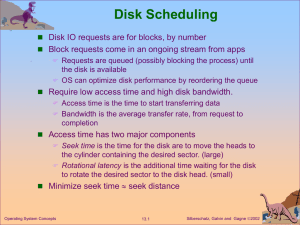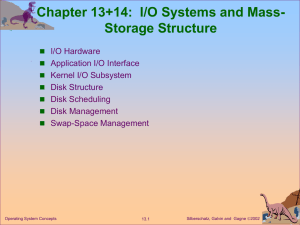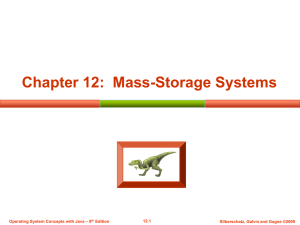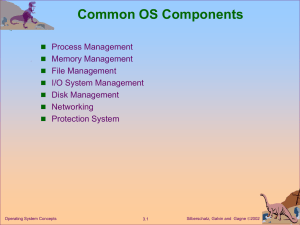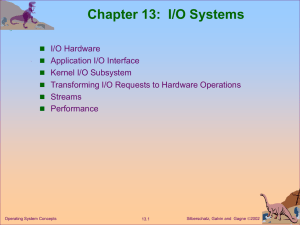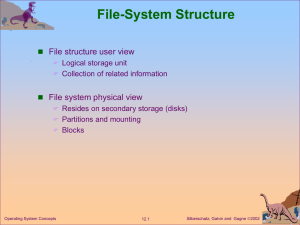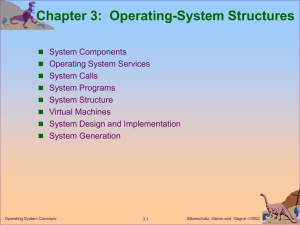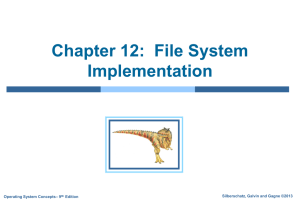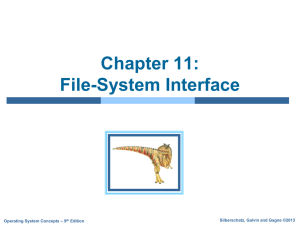(Silberschatz) Mass Storage Systems
advertisement
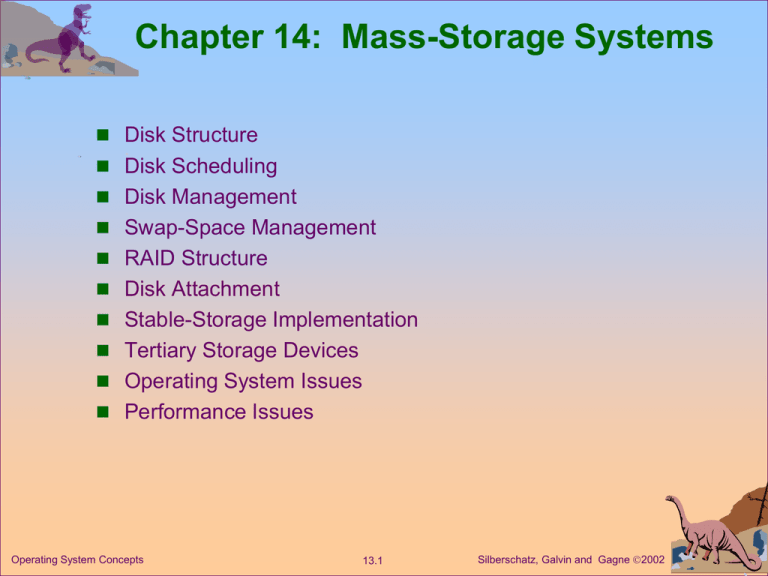
Chapter 14: Mass-Storage Systems Disk Structure Disk Scheduling Disk Management Swap-Space Management RAID Structure Disk Attachment Stable-Storage Implementation Tertiary Storage Devices Operating System Issues Performance Issues Operating System Concepts 13.1 Silberschatz, Galvin and Gagne 2002 Disk Structure Disk drives are addressed as large 1-dimensional arrays of logical blocks, where the logical block is the smallest unit of transfer. The 1-dimensional array of logical blocks is mapped into the sectors of the disk sequentially. Sector 0 is the first sector of the first track on the outermost cylinder. Mapping proceeds in order through that track, then the rest of the tracks in that cylinder, and then through the rest of the cylinders from outermost to innermost. Operating System Concepts 13.2 Silberschatz, Galvin and Gagne 2002 Disk Scheduling The operating system is responsible for using hardware efficiently — for the disk drives, this means having a fast access time and disk bandwidth. Access time has two major components Seek time is the time for the disk are to move the heads to the cylinder containing the desired sector. Rotational latency is the additional time waiting for the disk to rotate the desired sector to the disk head. Minimize seek time Seek time seek distance Disk bandwidth is the total number of bytes transferred, divided by the total time between the first request for service and the completion of the last transfer. Operating System Concepts 13.3 Silberschatz, Galvin and Gagne 2002 Disk Scheduling (Cont.) Several algorithms exist to schedule the servicing of disk I/O requests. We illustrate them with a request queue (0-199). 98, 183, 37, 122, 14, 124, 65, 67 Head pointer 53 Operating System Concepts 13.4 Silberschatz, Galvin and Gagne 2002 FCFS Illustration shows total head movement of 640 cylinders. Operating System Concepts 13.5 Silberschatz, Galvin and Gagne 2002 SSTF Selects the request with the minimum seek time from the current head position. SSTF scheduling is a form of SJF scheduling; may cause starvation of some requests. Illustration shows total head movement of 236 cylinders. Operating System Concepts 13.6 Silberschatz, Galvin and Gagne 2002 SSTF (Cont.) Operating System Concepts 13.7 Silberschatz, Galvin and Gagne 2002 SCAN The disk arm starts at one end of the disk, and moves toward the other end, servicing requests until it gets to the other end of the disk, where the head movement is reversed and servicing continues. Sometimes called the elevator algorithm. Illustration shows total head movement of 208 cylinders. Operating System Concepts 13.8 Silberschatz, Galvin and Gagne 2002 SCAN (Cont.) Operating System Concepts 13.9 Silberschatz, Galvin and Gagne 2002 C-SCAN Provides a more uniform wait time than SCAN. The head moves from one end of the disk to the other. servicing requests as it goes. When it reaches the other end, however, it immediately returns to the beginning of the disk, without servicing any requests on the return trip. Treats the cylinders as a circular list that wraps around from the last cylinder to the first one. Operating System Concepts 13.10 Silberschatz, Galvin and Gagne 2002 C-SCAN (Cont.) Operating System Concepts 13.11 Silberschatz, Galvin and Gagne 2002 C-LOOK Version of C-SCAN Arm only goes as far as the last request in each direction, then reverses direction immediately, without first going all the way to the end of the disk. Operating System Concepts 13.12 Silberschatz, Galvin and Gagne 2002 C-LOOK (Cont.) Operating System Concepts 13.13 Silberschatz, Galvin and Gagne 2002 Selecting a Disk-Scheduling Algorithm SSTF is common and has a natural appeal SCAN and C-SCAN perform better for systems that place a heavy load on the disk. Performance depends on the number and types of requests. Requests for disk service can be influenced by the fileallocation method. The disk-scheduling algorithm should be written as a separate module of the operating system, allowing it to be replaced with a different algorithm if necessary. Either SSTF or LOOK is a reasonable choice for the default algorithm. Operating System Concepts 13.14 Silberschatz, Galvin and Gagne 2002 Disk Management Low-level formatting, or physical formatting — Dividing a disk into sectors that the disk controller can read and write. To use a disk to hold files, the operating system still needs to record its own data structures on the disk. Partition the disk into one or more groups of cylinders. Logical formatting or “making a file system”. Boot block initializes system. The bootstrap is stored in ROM. Bootstrap loader program. Methods such as sector sparing used to handle bad blocks. Operating System Concepts 13.15 Silberschatz, Galvin and Gagne 2002 MS-DOS Disk Layout Operating System Concepts 13.16 Silberschatz, Galvin and Gagne 2002 Swap-Space Management Swap-space — Virtual memory uses disk space as an extension of main memory. Swap-space can be carved out of the normal file system,or, more commonly, it can be in a separate disk partition. Swap-space management 4.3BSD allocates swap space when process starts; holds text segment (the program) and data segment. Kernel uses swap maps to track swap-space use. Solaris 2 allocates swap space only when a page is forced out of physical memory, not when the virtual memory page is first created. Operating System Concepts 13.17 Silberschatz, Galvin and Gagne 2002 RAID Structure RAID – multiple disk drives provides reliability via redundancy. RAID is arranged into six different levels. Operating System Concepts 13.18 Silberschatz, Galvin and Gagne 2002 RAID (cont) Several improvements in disk-use techniques involve the use of multiple disks working cooperatively. Disk striping uses a group of disks as one storage unit. RAID schemes improve performance and improve the reliability of the storage system by storing redundant data. Mirroring or shadowing keeps duplicate of each disk. Block interleaved parity uses much less redundancy. Operating System Concepts 13.19 Silberschatz, Galvin and Gagne 2002 RAID Levels Operating System Concepts 13.20 Silberschatz, Galvin and Gagne 2002 RAID (0 + 1) and (1 + 0) Operating System Concepts 13.21 Silberschatz, Galvin and Gagne 2002 Disk Attachment Disks may be attached one of two ways: 1. Host attached via an I/O port 2. Network attached via a network connection Operating System Concepts 13.22 Silberschatz, Galvin and Gagne 2002 Network-Attached Storage Operating System Concepts 13.23 Silberschatz, Galvin and Gagne 2002 Storage-Area Network Operating System Concepts 13.24 Silberschatz, Galvin and Gagne 2002 Stable-Storage Implementation Write-ahead log scheme requires stable storage. To implement stable storage: Replicate information on more than one nonvolatile storage media with independent failure modes. Update information in a controlled manner to ensure that we can recover the stable data after any failure during data transfer or recovery. Operating System Concepts 13.25 Silberschatz, Galvin and Gagne 2002 Tertiary Storage Devices Low cost is the defining characteristic of tertiary storage. Generally, tertiary storage is built using removable media Common examples of removable media are floppy disks and CD-ROMs; other types are available. Operating System Concepts 13.26 Silberschatz, Galvin and Gagne 2002 Removable Disks Floppy disk — thin flexible disk coated with magnetic material, enclosed in a protective plastic case. Most floppies hold about 1 MB; similar technology is used for removable disks that hold more than 1 GB. Removable magnetic disks can be nearly as fast as hard disks, but they are at a greater risk of damage from exposure. Operating System Concepts 13.27 Silberschatz, Galvin and Gagne 2002 Removable Disks (Cont.) A magneto-optic disk records data on a rigid platter coated with magnetic material. Laser heat is used to amplify a large, weak magnetic field to record a bit. Laser light is also used to read data (Kerr effect). The magneto-optic head flies much farther from the disk surface than a magnetic disk head, and the magnetic material is covered with a protective layer of plastic or glass; resistant to head crashes. Optical disks do not use magnetism; they employ special materials that are altered by laser light. Operating System Concepts 13.28 Silberschatz, Galvin and Gagne 2002 WORM Disks The data on read-write disks can be modified over and over. WORM (“Write Once, Read Many Times”) disks can be written only once. Thin aluminum film sandwiched between two glass or plastic platters. To write a bit, the drive uses a laser light to burn a small hole through the aluminum; information can be destroyed by not altered. Very durable and reliable. Read Only disks, such ad CD-ROM and DVD, com from the factory with the data pre-recorded. Operating System Concepts 13.29 Silberschatz, Galvin and Gagne 2002 Tapes Compared to a disk, a tape is less expensive and holds more data, but random access is much slower. Tape is an economical medium for purposes that do not require fast random access, e.g., backup copies of disk data, holding huge volumes of data. Large tape installations typically use robotic tape changers that move tapes between tape drives and storage slots in a tape library. stacker – library that holds a few tapes silo – library that holds thousands of tapes A disk-resident file can be archived to tape for low cost storage; the computer can stage it back into disk storage for active use. Operating System Concepts 13.30 Silberschatz, Galvin and Gagne 2002
